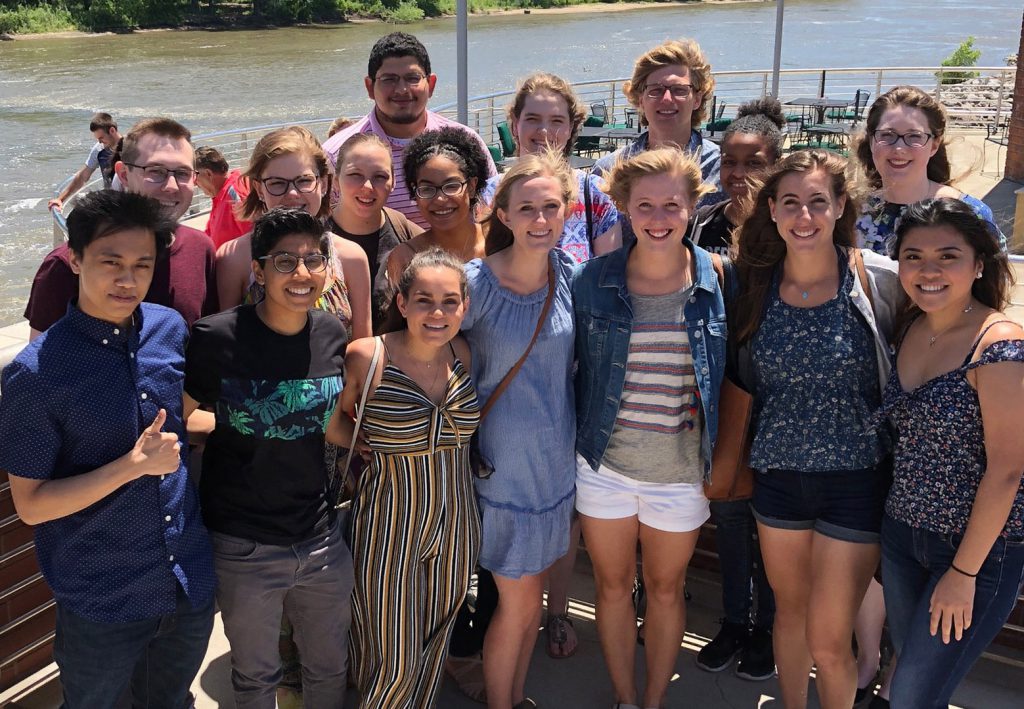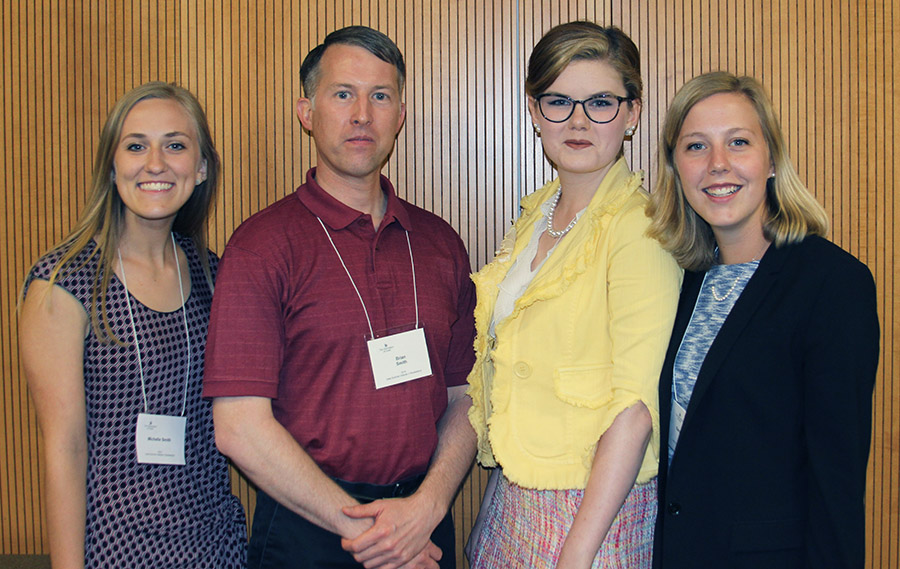Breadcrumb
A Statistically Significant Summer
By Debra Venzke
Published on July 31, 2018
The Iowa Summer Institute in Biostatistics introduces undergraduates to biostatistics and real-world research.

Data crunching isn’t a typical summer activity for most college students, but for 16 undergraduates who traveled to the University of Iowa to attend the Iowa Summer Institute in Biostatistics (ISIB), it was a big part of their skill-building experience. During this seven-week program based in the College of Public Health, students with a knack for mathematics are introduced to biostatistics and work in teams with a faculty mentor on a health-related research study, culminating in a final presentation of their project.
ISIB has been drawing talented students from around the nation since 2008, but this year, one team’s research experience won’t end with the last day of the program — instead, the students will continue their work under the supervision of a faculty member at their home institution, along with guidance from their UI faculty mentor. The ultimate goal is to produce a published paper.
This continuing research collaboration is a new addition to ISIB, and is a pilot project aimed at building a stronger research education network consisting of the institute, small liberal arts colleges, and graduate programs in biostatistics.
Building Stronger Ties
The idea for the collaborative project grew out of feedback from faculty at small colleges that refer students to the Iowa Summer Institute in Biostatistics.
“It came to our attention, during the 2017 annual Joint Statistical Meetings, that some of our faculty contacts in small liberal arts colleges couldn’t keep pace with their research agenda due to heavy teaching loads,” notes Gideon Zamba, UI professor of biostatistics and director of ISIB. “Collaborating with faculty from Research-1 institutions was appealing to them. Given that many of our summer research projects can easily lead to publishable research, we decided to pilot test a new collaboration that will build stronger ties with students’ home institutions.”
In addition to enriching students’ biostatistics skills and bolstering participating faculty members’ research portfolios, the aim is that, over time, ongoing partnerships will lead to a research education consortium and a “pipeline” for students to enter biostatistics graduate programs.
The inaugural faculty partner in the pilot project is Darcie Delzell, associate professor of mathematics at Wheaton College, a private liberal arts college located about an hour west of Chicago. Three of Delzell’s students participated in the summer institute and were mentored at Iowa by Brian Smith, professor of biostatistics.
The institute, which is funded by the National Heart Lung and Blood Institute, gives priority for admission to underrepresented minorities and disadvantaged students and to students from small liberal arts colleges that lack a substantial statistical curriculum.
“Wheaton offers courses in statistics, but doesn’t have a statistics department. So the students have had some exposure to stats at their college, but are getting more through our summer program,” says Smith. “They’ll take their project back to Wheaton and continue to work on it with their mentor as an independent research project for which they’ll get class credit.”
“I thought the opportunity for faculty at a research university and a primarily teaching college to work together to give students a top-notch research experience was a great idea,” says Delzell about the pilot project. “It not only allows the students to experience real statistical research, but also gives them the opportunity to take this research all the way to publication of the results. There are a lot of summer-only opportunities for students to do research, but it’s rare that research can continue under the mentoring of a faculty member at the students’ own institutions.”
Learning New Methods

For the three Wheaton College students — Tabitha Peter, Michelle Smith, and Sara Magnuson, who will all be entering their senior year when they return to school this fall — the summer institute has offered a number of benefits.
“For me, deciding to participate in the institute was a perfect opportunity to gain an introduction to biostatistics while learning how to apply statistical techniques to scientific research in the health-related fields,” says Michelle Smith, a math major. “I’ve enjoyed being part of a cohort of students with different backgrounds and having the opportunity to learn alongside and from each of them.”
“The three of us were very excited about the prospect of working on a longer-term research project as well as learning more about and continuing to take classes in applied statistics,” adds Sara Magnuson, who is majoring in applied mathematics and economics.
For their research project, Peter, Smith, and Magnuson are developing statistical models for medical imaging screening of patients at high risk for lung cancer.
“This is a study that was conducted at Iowa, and the students are working with a subset of the study that includes 200 patients who had a lesion on their CT scan,” Brian Smith explains. “Those patients went on to have a biopsy to tell definitively whether the lesion was malignant or benign.”
The goal of the project is to build predictive statistical models using information from the medical images along with patient demographics to predict which lesions will be malignant or benign, potentially reducing the number of patients who receive biopsies.
“This particular project uses machine learning techniques to build the statistical models,” Brian Smith continues. “Machine learning is used a lot in the tech industry by companies like Google, Amazon, and Facebook, and for things like autonomous driving and face recognition. Essentially, machine learning helps automate the process of building prediction models from data that contain complex patterns and relationships.
“This is something the students would not have seen at their home institution, and it’s new to their mentor as well. The nice thing about this project is that the students are getting exposed to new statistical methods, and they’ll be able to take this back to Wheaton to work on with Dr. Delzell, so they’ll all learn together.”
Delzell visited the UI early on during the institute to meet with Brian Smith and learn more about the students’ project. At the end of the program, the two professors assessed what aspects of the project were completed, what was left to future work, and what will be needed to move the project toward publication.
Research, Patience, and Career Possibilities
The hands-on research experience was eye-opening for the three students.
“Professor Zamba jokingly said it best: ‘You search, and then you search again, and again… this is why we call it research,’” says Tabitha Peter, a math major. “I’ve learned so much about the perseverance required to do good research; it is a process that has helped me cultivate patience. It’s been humbling to realize how much we don’t know.”
“Going through the research process, it has been cool to read books and papers on topics and models that I then got to try and apply to our data set. It’s helped me realize how open-ended and explorative research can be,” Magnuson says. “I’ve also learned a lot about patience because some of our code for our research has taken hours to run, and at times it can feel a lot like watching paint dry.”
Outside of class, summer institute participants had time to relax and socialize with other ISIB students and UI graduate students in biostatistics.
“I’ve been so thankful for all of the activities that the graduate students have planned for us; we have been to baseball games, had game nights, and cooked together,” adds Peter. “The faculty have been so inviting and available. The hospitality of the Iowa biostatistics department is most impressive.”
Along with a strong network of peers and firsthand research experience, ISIB participants come away with a better sense of career possibilities.
“One highlight of the institute has been all the speakers from the different areas of biostatistics. We’ve heard about opportunities to use biostatistics in industry, academia, research, government, and so much more,” says Magnuson.
“My hope is that the students will experience how fun and interesting collaborative research can be and that this will help guide them as they make future career choices,” adds Delzell. “Statistics is a fascinating field; these students are learning what it’s really like to do statistical research outside of the confines of classroom assignments and grades, and they are working on projects that have the potential to help people and contribute to medical science.”